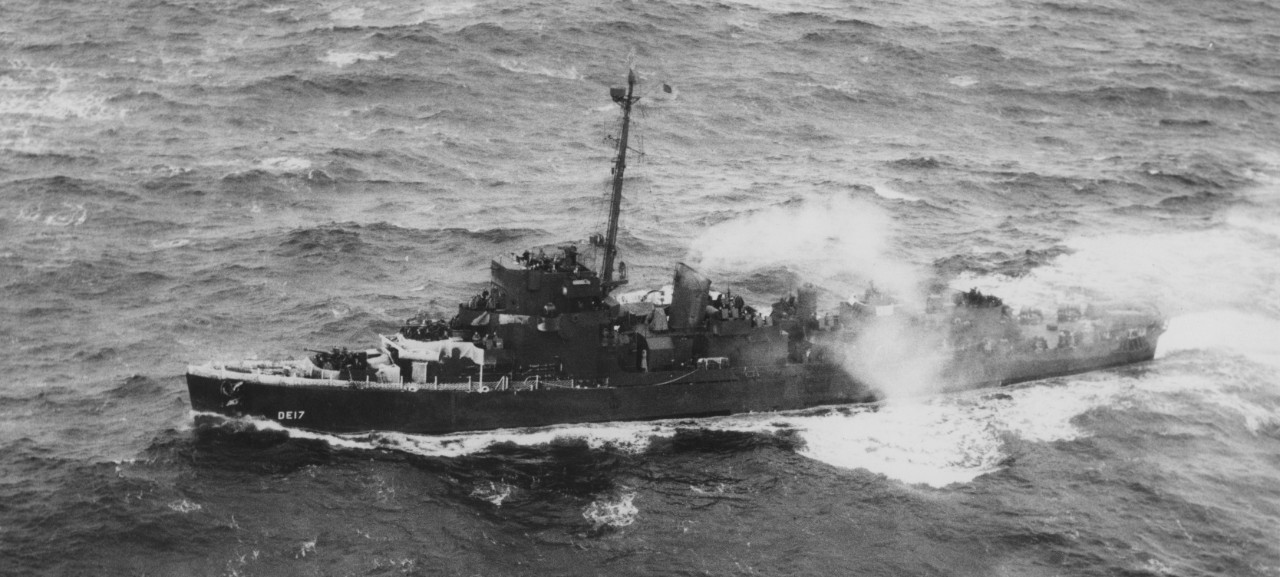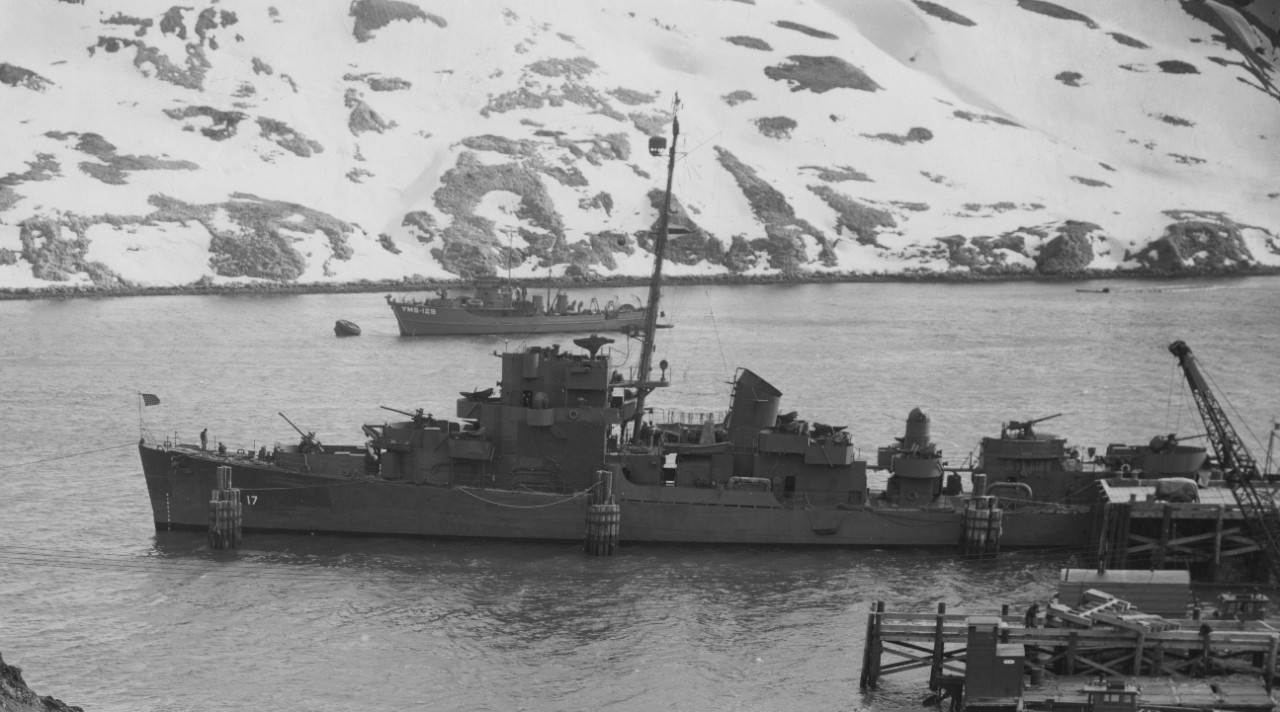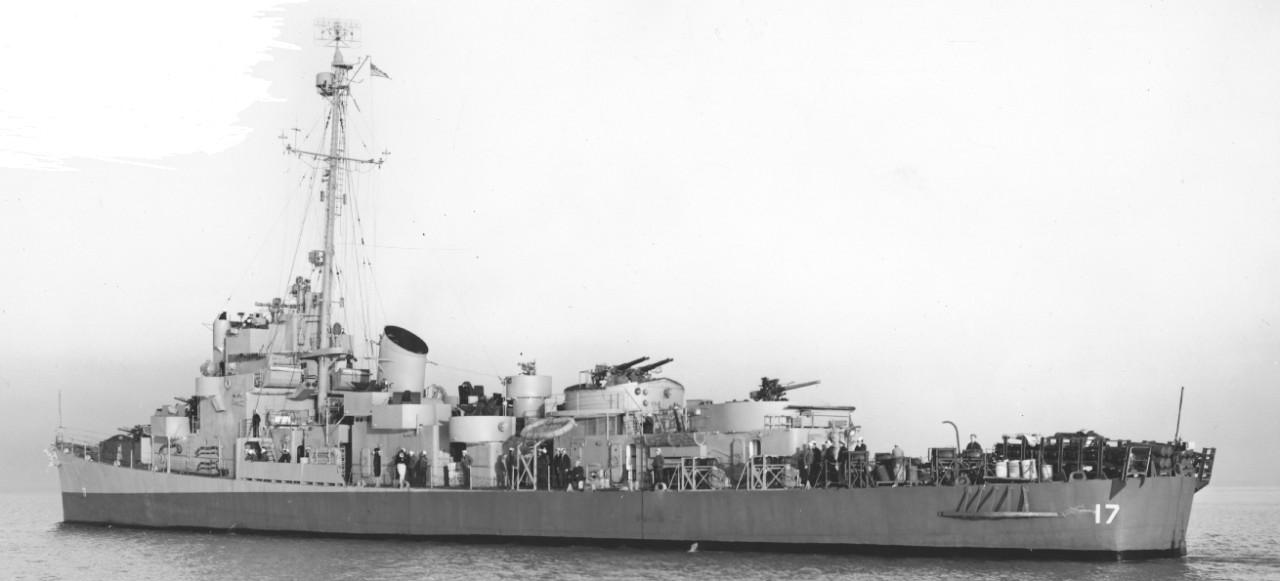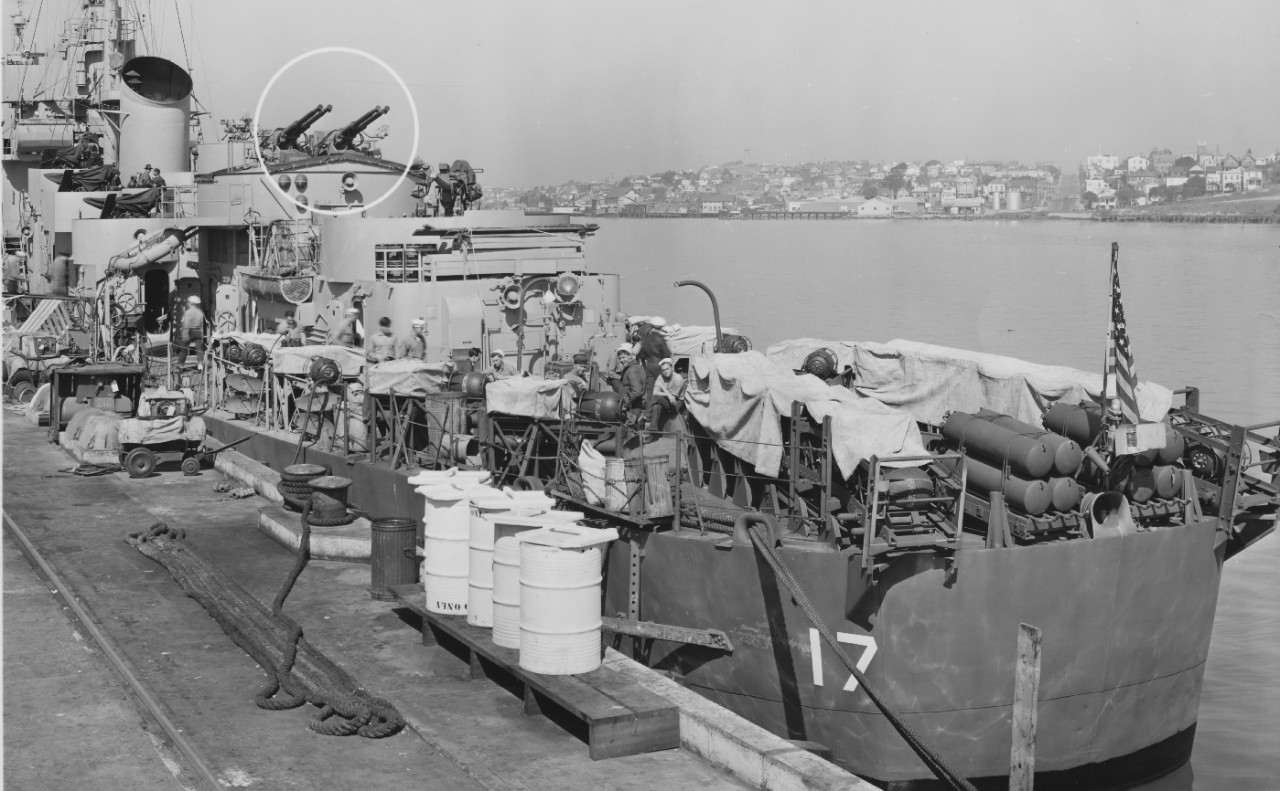Edward C. Daly (DE-17)
1943–1946
Edward Carlyle Daly – born on 27 April 1914 at Pink Hill, N.C. – enlisted in the U.S. Navy as an apprentice seaman, for a period of four years, on 13 February 1934 at the Navy Recruiting Station, Raleigh, N.C., and was transferred to the Naval Training Station, Norfolk, Va., the same day. Rated a seaman second class on 13 June 1934, he joined the heavy cruiser Chester (CA-27) a fortnight later [27 June], and a little less than two years later, on 27 May 1936, was advanced in rate to seaman first class. Transferred to the transport Chaumont (AP-5) on 17 June, he was received at the Receiving Station, Naval Operating Base (NOB), Norfolk, Va., on 13 July. Transferred to the Norfolk Navy Yard, Portsmouth, Va., on 11 September, he was transferred again, to the new destroyer Downes (DD-375), on 15 January 1937.
Daly received a Good Conduct Medal on 26 February 1938, and extended his enlistment for two years (to expire 26 February 1940), the following day (27 February 1938). Rated coxswain while serving in Downes, on 16 February 1940, he received an honorable discharge at that rate on 23 February, but reenlisted the next day on board the destroyer to serve a period of four years. Outside of a tour of duty in destroyer tender Dobbin (AD-3) (27 May 1940-1 March 1941), Daly spent the remainder of his time in the naval service in Downes.
On 7 December 1941, when planes from six Japanese carriers attacked the U.S. Pacific Fleet at Pearl Harbor, as well as nearby naval and military installations on Oahu, T.H., Downes lay in Dry Dock No. 1 at the Pearl Harbor Navy Yard, next to her sister ship Cassin (DD-372) and ahead of the battleship Pennsylvania (BB-38). Badly damaged by Japanese bombs and set ablaze, Downes was soon abandoned. Coxswain Daly bravely sought to save a badly wounded shipmate after an oil fire forced the abandonment of the forward part of the ship, but perished in the attempt, his “courageous and daring attempt” resulting in his receiving (posthumously) the Navy Cross.
(DE-17: displacement 1,140; length 289'5"; beam 35'1"; draft 8'3"; speed 21 knots; complement 156; armament: 3 3-inch, 2 40 millimeter, 9 20 millimeter, 2 depth charge tracks, 8 depth charge projectors, 1 depth charge projector (Hedgehog); class Evarts)
Byard (BDE-16) -- originally intended as an escort ship for the British Royal Navy under Lend Lease -- was laid down on 1 April 1942 at Vallejo, Calif., by Mare Island Navy Yard; launched on 21 October 1942; sponsored by Mrs. Diane L. S. McQuilkin, wife of Lt. John H. McQuilkin; reallocated to the U.S. Navy; reclassified to DE-17 on 25 January 1943; renamed Edward C. Daly on 19 February 1943; and commissioned on 3 April 1943, Cmdr. George A. Parkinson, USNR, in command.
Edward C. Daly began her sea trials in San Pablo Bay, an estuary of San Francisco Bay and the home to Mare Island Navy Yard on 11 April 1943. On 19 April, she sailed through the Golden Gate to continue her training in convoy escort duty and anti-submarine warfare at San Diego, Calif., marking the first time that more than 100 of her crewmen put to sea. Over the next several weeks in San Diego, she participated in an intense training schedule sailing in the company of many vessels including destroyers McCook (DD-496) and Rathburne (DD-117), minesweeper Herald (AM-101), Coast Guard cutters Morris (WPC-36) and Perseus (WPC-114), and submarines S-34 (SS-139) and S-45 (SS-156) serving as her quarry. The Navy also featured Edward C. Daly in a training film conducting antisubmarine exercises.
On 22 April 1943, Edward C. Daly set out for Honolulu, T.H., to begin her career escorting convoys between Pearl Harbor, in the Hawaiian Islands, and San Francisco. A number of dignitaries inspected the ship at Pearl Harbor including Adm. Chester W. Nimitz, Commander-in-Chief, Pacific Fleet, and his deputy, Adm. Raymond A. Spruance. The ship joined convoy No. 4453 in company with troop transport Santa Cruz, tank landing ship LST-110, and 12 merchantmen to San Francisco (30 May–9 June). She continued to operate between San Francisco and Honolulu in addition to serving as a school ship for training on her sound detection equipment at Pearl Harbor.
With the war effort gaining momentum in the Pacific, Edward C. Daly was reassigned to Funafuti Atoll in the Ellice Islands [Tuvalu], on 14 August 1943. The ship set out escorting attack transport Ormsby (APA-49), and while underway to her new assignment, crossed the equator on 19 August, and, as part of a longstanding naval tradition, held a ceremony to initiate her crewmembers in entering the Order of Neptune. With her “pollywogs” now proper “shellbacks,” she anchored at Fongafale at Funafuti on 21 August. During her assignment, she escorted merchant and fighting ships between several different islands in her immediate vicinity and to Pearl Harbor.
Most of these voyages proved uneventful due to declining Japanese power, but that changed on the night of 12 September 1943. While her crew enjoyed a film on her fantail, Japanese bombs fell on Funafuti. The attack caught everyone off guard but Edward C. Daly immediately went to battle stations. The raid opened a battle that raged into the night, and three more attacks came in roughly 45 minute intervals, just enough time for the sailors to stand down only to be jolted back to battle station from their berths. The final attack began at 0453 on 13 September and lasted for ten minutes. Investigators determined that the enemy attacked undetected because they approached from an altitude of around 25,000 feet. A total of 15 Japanese bombers struck the atoll, and although the attack had some impact, Edward C. Daly emerged unscathed and American antiaircraft fire splashed one of the attackers.
In mid-September 1943, Edward C. Daly provided screening for several ships and landing craft about 250 nautical miles northeast to Nanomea Island before shifting her assignment to Pago Pago in American Samoa. On 5 October, she was called upon to rescue survivors from a downed Consolidated PBY-5A from Marine Aircraft Group 13 operating from Funafuti. First Lieutenant Paul J. Sax, USMC, had landed his PBY-5 to rescue crewmen of a land based aircraft that had crashed in the sea. After recovering his fellow airmen, Sax attempted to lift off in dangerously high seas, but was killed in the ensuing crash, leaving his crewman and the other survivors adrift. The ship arrived at 2300 to find the Catalina in flames, and launched whale boats in heavy seas to search for the crew. One boat returned with nine marines. Edward C. Daly temporary broke off the rescue efforts after her sonar reported a submerged contact. After losing contact, she returned to search for survivors and pulled seven more men from the water, as well as one fatality. The ship attempted to salvage the Catalina but the heavy seas proved too dangerous and she sank the plane with gunfire. At 0330 on 6 October 1943 the fuel tank exploded and the aircraft sank beneath the waves. Edward C. Daly buried Sax at sea approximately 640 nautical miles southeast of Funafuti on 6 October.
With the remaining airmen on board, Edward C. Daly made her way to Canton Island, where she disembarked her passengers, and returned to Funafuti on 11 October 1943. The next day she shaped a course for Pearl Harbor. The escort vessel departed Oahu for San Francisco on 18 October, and two days later rendezvoused with the destroyer Halford (DD-480) and convoy No. 18345 en route to the west coast. Edward C. Daly moored at San Francisco on 27 October, before moving to the Bethlehem Steel docks where she underwent maintenance, and then shifted to Treasure Island on 25 November. On 28 November, the veteran ship turned her prow northward to her new assignment at Adak, Alaska.
Heavy seas lashed the ship mercilessly while she steamed off the coast of the Pacific Northwest. Edward C. Daly made less than one mile headway in 24 hours through waves towering up to 75 feet while her crew struggled to keep her equipment secured (29-30 November 1943). Life rafts on her starboard weather deck broke free, and several crewmen received minor injuries while returning the rafts to their stanchions, and a sailor suffered a severe knee sprain while assisting a shipmate. With the storm behind her, Edward C. Daly reached Kuluk Bay, Adak, on 8 December. With the exception of a brief visit to the area firing range (23–24 December), she remained moored until the New Year.
On 2 January 1944, Edward C. Daly moved to Finger Bay on Adak. Examination of her hull revealed that her sound gear had been torn away, and the ship entered Drydock No. 1034 for repairs (2–4 January) and then returned to Kuluk Bay. She finally received her first mission as a member of Task Force (TF) 91.2 and made for the extreme western Aleutian island of Attu on 6 January, from where she escorted troopship Toloa from Attu to Kiska Island.

Edward C. Daly spent the entirety of 1944 escorting multiple Navy and commercial vessels between the various Aleutian Islands. She also served as a weather and homing ship for planes flying bombing raids on Paramushiro Island from Attu. On many occasions, her radar detected an incoming aircraft and the crew manned their battle stations only to discover an Allied plane that failed to engage its onboard IFF (identification friend or foe) transponders.

A similar situation caused by a breakdown in communication nearly ended in disaster on 24 March 1944. At 0455, Edward C. Daly detected a surface contact on radar, feared a likely Japanese submarine attempting to infiltrate past the screen, and sounded general quarters and closed on the target. At 0520, she hailed the vessel asking for its call sign, to which the suspect transmitted incorrect information. As Edward C. Daly approached within visual range, lookouts sighted a ship, not a submarine. She trained her guns on the target and again challenged the vessel via radio, and only then identified the stranger as the venerable ocean tug Tatnuck (ATO-27). In accordance to standing orders, Edward C. Daly was to be kept abreast of friendly ships operating in her patrol area, but had not received such communication.
Although her operations grew increasingly redundant without contacting the enemy, the crew remained diligent and eager, while combing the sea for potential threats. On 13 April 1944, while escorting liberty ship Carl Schurz and tanker Mission Solano to Dutch Harbor, Alaska, Edward C. Daly identified a subsurface contact as potentially an enemy submarine. Sonar signals indicated that the contact was in motion, but in order to avoid an “embarrassing” attack, she maneuvered for 20 minutes to verify the target. Once the ship’s antisubmarine team classified the echoes as a submarine, the ship began firing, employing her “Hedgehog” forward-throwing antisubmarine weapons. The apparent submarine drifted left, so the escort’s commanding officer ordered her toward the bearing of the contact. The Hedgehog rounds detonated at an estimated depth of 475 feet in an area indicated to be 400 feet according to her charts. Isherwood (DD-520) operated nearby on a different mission and approached the area. Edward C. Daly turned the contact over to her and returned to her escort duties, and upon further investigation, Isherwood determined that Edward C. Daly had attacked an underwater pinnacle. Five days later on 18 April, when Edward C. Daly returned to the area, she duplicated the contact exactly as before, confirming Isherwood’s report.
![Edward C. Daly in Aleutian waters, in dazzle camouflage, circa 1 June 1944. Note her identification number [17] in a contrasting color. (U.S. Navy Bureau of Ships Photograph BS 131005, National Archives and Records Administration, Still Pictures ... Edward C. Daly in Aleutian waters, in dazzle camouflage, circa 1 June 1944. Note her identification number [17] in a contrasting color. (U.S. Navy Bureau of Ships Photograph BS 131005, National Archives and Records Administration, Still Pictures ...](/content/history/nhhc/research/histories/ship-histories/danfs/e/edward-c-daly-de-17/_jcr_content/body/media_asset_1502418983/image.img.jpg/1516121549795.jpg)
Edward C. Daly’s operations came to a close when she was ordered to return to San Francisco, in company with Gilmore (DE-18) and Doneff (DE-49), on 13 January 1945. After reentering the Golden Gate, she proceeded to Mare Island where she remained moored undergoing an extensive overhaul (19 January–25 February). On 26 February, she returned to sea and tested the sound gear off Point Chauncey in San Francisco Bay. The next day she moored at Treasure Island. For the next several days, Edward C. Daly was put through her paces to ensure she was ready for her next assignment, which arrived on 2 March 1945.


Under her new orders, Edward D. Daly proceeded on a voyage to Pearl Harbor in company with Doneff, to join TF 06.12.1 for duty under Commander, Western Sea Frontier, in the Pacific, on 3–9 March 1945. Edward C. Daly spent most of the month undergoing antisubmarine training and gunnery exercises preparing to return to the western Pacific. On 20 March 1945, she stood down the channel in company of Doneff, Engstrom (DE-50), and Austin (DE-15) as part of TF 19.8.17 en route to Eniwetok in the Marshall Islands. Later in the day, the group rendezvoused with ships from Commander Escort Division (CortDiv) 14, including Gilmore (DE-18); Clearfield (APA-42); Arenac (APA-128); Windsor (APA-55); J. Franklin Bell (APA-16); General Omar Bundy (AP-152); and Sherburne (APA-205). The convoy arrived at Eniwetok after an uneventful voyage on 30 March.
Edward C. Daly began April 1945 escorting ships between Eniwetok and Guam in the Marianas until her duty assignment shifted to Saipan, which included providing escort services between Saipan and Iwo Jima in the Kazan Rettō [Volcano Islands]. Her tasks also comprised patrolling around Saipan and remaining on station at several locations to provide search and rescue assistance for downed aircraft in the area. The ship also shepherded British escort aircraft carrier Ranee (D.03) [ex-Niantic (CVE-46)] from Eniwetok as far as Guam (5–10 April). The schedule became repetitive and routine until the early morning of 1 June 1945. While serving as a convoy escort, again en route to Iwo Jima, she was in the process of tracking an unidentified surface contract, when one of her lookouts spotted aircraft landing lights, at 0355. The aircraft, a USAAF Boeing B-29 Superfortress of the XXI Bomber Command with engines on fire, crashed into the water off Edward C. Daly’s starboard beam. The ship went to general quarters and plucked six survivors from the sea, while gasoline tanker Sequatchie (AOG-21) rescued two others. The ships rejoined the convoy and continued to Iwo Jima, where Edward C. Daly entered a brief period of maintenance and repairs (3–13 June 1945). She returned to her routine duties on 14 June 1945, operating between Saipan and Iwo Jima.
After the Battle of Okinawa (1 April–22 June 1945) in the Ryūkyū Islands, Edward C. Daly’s escort destination shifted to Buckner Bay, Okinawa [Nakagusuku Wan], named in honor of Lt. Gen. Simon Bolivar Buckner Jr., USA, Commander Tenth Army, killed there by a Japanese artillery round on 18 June 1945.
During most of August 1945, Edward C. Daly patrolled Air-Sea Rescue Station 18, some 200 nautical miles northwest of Saipan. This station lay just over 1,000 nautical miles from the main Japanese island of Honshū, and the crew often referred to this duty as a serving “Dumbo ship” or “parlor maid” duty. As the war drew to a close Edward C. Daly’s duties changed, and on 21 August, she returned to escort ships along her previous route between Saipan and Okinawa.
At the end of the month on 28 August 1945, she was underway with Gendreau (DE-639) to escort Pennsylvania (BB-38) to Guam. While the battleship had lain at anchor in Buckner Bay on August 12, an enemy bomber evaded detection and torpedoed Pennsylvania astern, killing 20 of her sailors, injuring ten more, and extensively damaging the ship. Pennsylvania could not steam under her own power and ocean tugs Serrano (ATF-112) and Tenino (ATF-115), and rescue tug ATR-9, took her under tow to Guam for repairs. The journey proceeded slowly but the group arrived at Guam on 6 September. It was during that mission that the Japanese surrendered on board Missouri (BB-63) on 2 September. With her mission accomplished, Edward C. Daly returned independently to Saipan (9 September). On 12 September, she stood out of Saipan and moored at Guam (13–21 September), before patrolling in the area of Truk Atoll in the Carolines (22–30 September).
With the war over, Edward C. Daly remained at Guam until carrying out antisubmarine training with Blueback (SS-326) on 7 October 1945. While returning to port, she received orders to change course, at 1445 on 7 October, and search for survivors of a crashed Superfortress, about 334 nautical miles northwest of Guam. The bomber had been en route from Okinawa to Guam carrying Brig. Gen. Joseph L. Loutzenhiser, USA, and several of his staff. At 1437 the following day, Edward C. Daly’s crew pulled 1st Lt. Stephen R. Gammon, USAAF, the plane’s pilot, from the water. Soon afterward, a Catalina landed to assist in the rescue effort but quickly sank in the heavy swells. Edward C. Daly rescued the PBY’s crew and returned to searching for survivors of the B-29. An hour later, she rescued another young USAAF officer, 2nd Lt. Ralph F. Deeson, USAAF.
The following day on 9 October 1945, the ship recovered the bodies of 2nd Lt. Francisco W. Rich, USAAF, and Tech. Sgt. Clemens B. Wojecki, USAAF, and buried them at sea at 1710, approximately 371 nautical miles northwest of Guam, near 17°05'N 139°31'E. The stores ship Aldebaran (AF-10) saved one other survivor, Tech. Sgt. Leon A. Kleber, USAAF. The search continued for several days (10–16 October), but Loutzenhiser and four other men were never recovered. Edward C. Daly received orders to return to Guam on 16 October.
According to a personal letter to his mother from on board Edward C. Daly, 1st Lt. Gammon had been in the water for around 36 hours wearing only his Mae West life preserver. At some point sharks attacked the pilot, “but they didn’t get me and I can say I kicked some of them pretty hard.” Gammon continued to serve in the USAF, flew combat missions during the Korean and Vietnam Wars, and retired as a lieutenant colonel in 1965.
On 22 October 1945, Edward C. Daly departed Guam for Pearl Harbor, and proceeded, via Eniwetok, to the U.S. She arrived at Terminal Island in Long Beach, Calif., on 5 November, where she was decommissioned on 20 December 1945. She was stricken from the Navy Register on 1 January 1946. Ten months later, on 11 November 1946, the vessel was sold to the Pacific Bridge Co., San Francisco, for scrap.
| Commanding Officers | Date Assumed Command |
| Cmdr. George A. Parkinson, USNR | 3 April 1943 |
| Lt. Alvin P. Chester, USNR | 12 June 1943 |
| Lt. Albert P. Merrill, USNR | 27 November 1943 |
| Lt. Cmdr. Gordon R. Deits, USNR | 12 February 1945 |
John W Watts Jr.
12 January 2018


